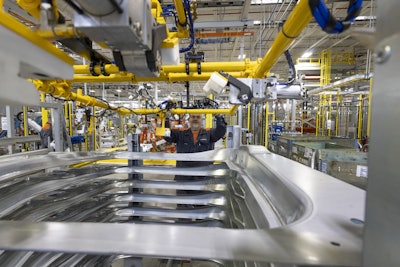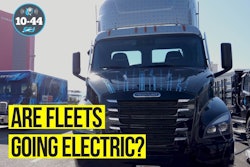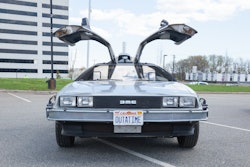
Battery-electric commercial trucks are already on the road in some areas and the segment, like it or not, is growing. Whether pushed by government regulations, corporate sustainability or other considerations, BEVs are poised to be a big part of a zero-emissions future for commercial vehicles.
[RELATED: Navistar's Carlbaum says electrification inevitable, but not without challenges]
Suppliers are gearing up to produce components for these high-tech trucks, and while most of these vehicles are new enough to be repaired under warranty for a few more years, opportunities are also starting to emerge for the heavy-duty aftermarket.
Dealers, meanwhile, are struggling with questions about servicing BEVs, but the answer to that might just be to keep it simple.
 Robots work on a truck at Daimler.Daimler Truck North America
Robots work on a truck at Daimler.Daimler Truck North America
Truck makers
Component selection starts with the original equipment spec’d into trucks on the factory floor. For BEVs, which are heavier, hotter and have less vibration than internal combustion powertrains, there are some special considerations for choosing components.
“Traditional vehicles use low-voltage systems (12-volt or 24-volt), but BEVs require high-voltage systems (400-volt to over 800 volts) for efficiency, introducing new complexities in component selection and design,” says Tyler Ohlmansiek, Mack Trucks’ director of e-mobility sales.
[RELATED: Mack Trucks busy at 2024 ACT Expo with electric truck news]
BEV components must be able to handle higher voltages, with better insulation and protection against voltage spikes and arcing. More voltage means more heat, too, and BEV components must be able to handle those temperatures and work well with other electromagnetic parts. The trucks also need to step down high voltage for auxiliary systems that run on lower voltages.
“As an example, the traction batteries are 600 volts, which ultimately power everything, but some of the components are 24-volt and some are 12-volt,” says Bobby Compton, product marketing manager, regional haul, at Volvo Trucks. “Though we do have two 12-volt batteries, they are wired in series to make 24 volts. The truck has a DC-to-DC converter to ensure the right voltage gets to the right place.”
Volvo says the diesel and electric versions of its VNR tractor are much the same, sharing parts including the doors, structure and many of the driveline components.
“We wanted to make sure our customers and dealers had an easier time adapting to this big change by keeping as much in common as possible,” Compton says.
The way electric motors deliver power also means many BEV transmissions are different, including Volvo’s, which is a two-speed transmission but still a Volvo I-Shift. Kenworth’s BEV transmissions are also different from their internal combustion counterparts.
“Due to the unique power delivery and torque curve of a BEV, you end up without the need for 18-speed and 12-speed offerings like you have for your traditional diesels, says Sarah Abernethy, Kenworth’s powertrain marketing manager.
Abernethy stresses Kenworth trucks are custom tailored to the buyer and the application. Design differences between its BEV and diesel trucks depend on the model and how it’s built. For e-axle powertrains such as the T680E, Abernethy says the rear of the vehicle will be very different than a diesel T680. But for a midships motor, it will be very similar, with the rear axle, driveline and suspension all similar to a diesel engine truck.
[RELATED: Mack building off-grid charging system into electric models]
Companies have also had to shift systems that traditionally run off a belt from the diesel engine. Climate control, power steering and other controls are still present on BEVs, but have been modified to run off electricity. Dr. Mihai Dorobantu, Eaton Mobility Group's director of technology planning and government affairs, says manufacturers often choose to keep some accessories belt-driven and drive the belt off an electric motor.
"This is cheaper and more reliable than electrifying each accessory individually," he says.
At Daimler, the air systems are also different.
“Air tanks, piping and dryers are still required, but the compressor needs to be changed to an electrically driven version, since a gear-driven one is no longer an option,” says Sam Saia, product marketing manager, eMobility. And where traditional ICE trucks have lubrication, fueling and other systems, BEVs require their own solutions for charging, power conversion and high-voltage distribution.
“We have taken the opportunity to develop some unique features on the Freightliner eCascadia that make the day in the life of a driver/fleet manager better,” says Len Copeland, product managing manager for Detroit. “Our diesel variants come standard with Detroit Connect, but our BEVs add a charger management system to allow for owners to validate the charging status of multiple vehicles, and even determine start and stop charging times to manage energy pricing in peak- or mid-electricity pricing zones.”
And while the lack of vibration is a boon for driver comfort, Navistar says it does have a trickle-down effect when it comes to components.
"BEV will have much less vibration noticed by the driver over ICE due to the engine," says Scott Smay, director of vehicle engineering and integration. "This improvement does not impact the design or selection of BEV components but does require additional focus on eliminating other noises like buzzing, squeaking or rattling on common cab or interior components."
Batteries are one of the most expensive and heaviest components OEMs will source for a vehicle.
"Battery power determines performance and battery size determines range," Dorobantu says. "However, high-power and low-range batteries have very limited life, which means that trucks that need high performance and low range will either get a much higher range battery or will need multiple low-range battery replacements. Both mean more battery than needed each day, thus driving up cost. The battery is by far the most expensive component of an e-truck, thus any additional batteries or larger batteries add to the truck's total cost of ownership."
That's why Bendix says it's important to maximize the battery's efficiency, and it offers solutions with brakes that reduce drag and increase range without increasing the size and cost of the battery.
"High range offers the fleets the potential for the greatest flexibility in operation," says Dave Schultz, director of aftermarket business development at Bendix. But a high range battery, because of the cost and weight, can be prohibitive. Instead, OEMs are turning to other solutions to get the range and duty cycles their customers require.
"Important contributors to efficiency extend well beyond the powertrain. Aerodynamic loads, rolling resistance and brake drag can all negatively impact a vehicle's efficiency and range," Schultz says. "There are significant ongoing engineering and testing activities (in design and manufacturing) to assure parts are designed and manufactured to specifications that meet the needs of the vehicle's application when the truck is new."
 Timken makes motion solutions, such as this brake and clutch. For BEVs, the company says it sources materials that can handle higher temperatures and increased speeds.Timken
Timken makes motion solutions, such as this brake and clutch. For BEVs, the company says it sources materials that can handle higher temperatures and increased speeds.Timken
Component suppliers
Suppliers are pivoting to adapt components for the unique operating environment for BEVs. Some things to take into consideration, Dorobantu says, are battery size and electric motor power, duty cycle and drivetrain.
"E-axles are heavy and disintegrate quickly on rough roads, but maximize space for batteries between the frame rails," he explains, "versus central drive that maintains compatibility with the ICE version of the truck and allows more speeds in the transmission, but may restrict space between the frame rails."
Those e-axles contain some expensive components, Dorobantu says, and they're in a harsh environment, which can shorten the life of parts such as the traction inverter and the gear box.
Mack considers several factors when designing and selecting parts for its BEVs, Ohlmansiek says. Suppliers’ supply chains must be reliable and the components they deliver need to be durable and serviceable. The parts also need to be light, make use of available space efficiently, and be well supported in the aftermarket.
Gates Corporation makes fluid power and power transmission solutions. This includes hoses, electric water pumps, coolant valves and oil cooler lines for BEVs. Its team includes Frank Woodson, training manager, North American aftermarket; Ken Pancoast, global product line manager, automotive aftermarket; Robert Schuld, global product line manager, automotive aftermarket; Chris Hack, global modular hose program manager; and Brian Holt, global EV product line manager.
“Most of our efforts surrounds the cooling system,” the team says in a prepared statement. “Hose connections are also critical parts of the system and must be designed to work in limited spaces as batteries are stacked upon other batteries.”
The cooling systems are important to keep batteries at a safe, optimized temperature. And these systems have to be durable. The Gates team points out the thermal management systems are working even when the vehicle isn’t. Even as the truck charges, this components in this system are running to keep the truck’s batteries at an optimal temperature for charging.
Hendrickson makes heavy-duty suspensions, which are important parts for the often-heavier BEVs. Jeff Zawacki, vice president of the company’s advanced technology group, says these components, along with bushings, brakes and tires, will all be similar but may include some material difference specific to BEVs, such as a different compound rubber in the tires to improve wear.
[RELATED: Hendrickson acquires Reyco Granning]
“Obviously, the driveline being electric will eliminate the need for all the exhaust emissions parts,” he says, “and engine rebuilds would likely be replaced with motor rewinding over time.”
Bendix says its solutions for BEVs are designed to maximize the vehicle's efficiency, and sometimes that can be too much of a good thing. Dan Zula, director of the brake redundancy product group, explains that regenerative braking uses the electric powertrain as a generator during deceleration, converting kinetic energy back into electric energy to recharge the battery.
"On an electric vehicle ... the regen function can supplement foundation braking for decelerating the vehicle," he says. "This is important for preventing overheated brakes on steep grades and is similar to how diesel engine compression braking helps foundation brakes today. However, if the vehicle battery is full or if the battery would be damaged by the rate of charge available from high regen periods, the excess energy will need to be diverted to a new component."
Timken makes bearings and other motion solutions for industrial applications, including heavy duty commercial vehicles.
“Every mile counts for a BEV, so component efficiency and reduced heat generation can be vital to extending the range of the battery and the vehicle,” says Derek Mankin, senior application engineer at the company. “This factors into how we design and develop bearings, from enhanced surfaces to optimized internal geometries and proper sizing. All these elements are crucial for enhancing driveline efficiency and maximizing a vehicle’s performance across its entire range.”
He says Timken works with its customers, including OEMs, to choose the best solution for performance and sustainability. In BEVs, this means selecting materials that can cope with higher temperatures and increased speeds. At the same time, OEMs are trying to keep their component lists simple and increase their speed to market. Like Volvo, they’re putting components made for diesel trucks in their BEVs.
“In all cases, we work with them to determine the most efficient and best-performing option,” Mankin says, adding that now first- and second-generation BEVs are on the road, the company is seeing an uptick in clean-sheet designs rather than repurposing what’s already in use. Either way, Timken says it’s ready.
“If that means selecting from our existing portfolio or innovating and creating something new, we will collaborate with our customers to identify the right solution,” he says.
 This electric Kenworth cabover was delivered to Kittle's Furniture in Indiana by Palmer Leasing. For dealers, Kenworth says knowing the customers, their applications and needs can help keep the right BEV components in stock.Kenworth
This electric Kenworth cabover was delivered to Kittle's Furniture in Indiana by Palmer Leasing. For dealers, Kenworth says knowing the customers, their applications and needs can help keep the right BEV components in stock.Kenworth
Dealers
While BEVs are gaining in popularity, Dorobantu says some supply chain issues remain that dealers and shops need to be aware of.
"I think dealers have to be careful with batteries, inverters and motors," he says. "These can quickly become scarce as the supply chains are still fragile. I think dealers need to also understand that e-trucks sold today are first-generation trucks, so significant changes can and will occur in the next 3-4 years."
Mack provides a recommended stocking list to dealers for its battery electric products, which includes high-usage parts and those essential for maintaining and servicing the vehicles. Some of the parts included are brake components and thermal control system components, along with serviceable electrical components such as converters and inverters, sensors and control units.
[RELATED: How to effectively sell alternative power]
Ohlmansiek advises dealers to take the list and tailor it to local needs.
“By focusing on these critical components and adjusting stock based on local demand, dealerships can ensure they are prepared to service BEVs efficiently in their area of responsibility,” he says.
Volvo is taking a strategic approach with its VNR Electric. It certifies EV dealers around the country and ensures, before a VNR Electric is deployed, it will work in an area with certified EV dealers for service, Compton says. Part of the certification process is determining key components to keep on hand for the truck.
Daimler also keeps the focus on maintaining uptime, advising dealers to stock critical components to keep their trucks on the road.
“My second piece of advice would be to stock components that are already understood and have carried over or that are similar to prior ICE versions at similar rates,” Saia says.
Kenworth’s Abernethy says dealers need to make sure the BEVs they’re selling are being used appropriately, within the limits of weight and range. That, along with knowing what parts the customers need, goes back to a thorough understanding of what the trucks are doing in the field.
“All told, dealers need to know their customer base very well to understand what will work best for their stocking needs — both for BEVs and for diesels,” she says.
Navistar also sends its dealers a parts list for both BEV and diesel engines and also stocks some parts only at parts distribution centers, ready to ship out when needed.
Training is also important, Schultz says.
"Many of the components are the same, but the complexity of the system has increased," he says. "The first step is to gain training on how to diagnose and repair the BEVs properly. For replacement parts, it's important to replace like with like and use genuine replacement parts — the same components used when the vehicle was built."
 A Mack electric refuse truck is plugged in for charging. Thermal management systems, which run even while trucks are charging, are one opportunity for the heavy-duty aftermarket to supply battery electric trucks.Mack Trucks
A Mack electric refuse truck is plugged in for charging. Thermal management systems, which run even while trucks are charging, are one opportunity for the heavy-duty aftermarket to supply battery electric trucks.Mack Trucks
Aftermarket
As BEVs age, the aftermarket has an opportunity to step in and innovate. A key area where the Gates team sees an opportunity for aftermarket growth is in the thermal management system components, largely because of its heavy use cycle.
[RELATED: Schwartz, MacKay look decades into future powertrains]
The company has also seen replacement rates on BEV electric water pumps hold steady with internal combustion engine electric water pumps, “so we know parts on BEVs are going to fail and wear out,” the team says.
Suspension components will also present at opportunity, Gates says, because of most BEVs’ heavier weights, and brakes as well, for the same reason.
Volvo’s Compton says he looks for body builders to play a larger role in the BEV aftermarket, configuring things such as liftgates and reefers to work on electric trucks.
“Technology will continue to evolve and get better, opening up many new possibilities,” he says.
The aftermarket can also help improve uptime for customers.
“I would imagine that readiness with large critical aggregates availability would be paramount, in addition to systems that are already well understood as common issues, such as harnessing, cooling and air systems,” Saia says.
Smay, at Navistar, says his company is looking to the aftermarket for the more simple components of BEVs, such as coolant pumps, valves and cooling modules.
As BEVs continue to filter through the heavy-duty marketplace, Dave McCleave, director of aftermarket at Hendrickson, advises dealers and distributors, again, to know their customer. Paying attention to the fleets running BEVs and how they’re using them will let them know what parts are wearing out more quickly. These should be kept on hand.
“This will ensure maximum equipment uptime with local inventory,” McCleave says. “The less-strategic, longer-wear components or large-space items should be inventoried at a national distribution center.”












